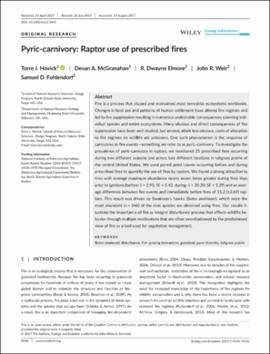| dc.contributor.author | Hovick, Torre J. | |
| dc.contributor.author | McGranahan, Devan A. | |
| dc.contributor.author | Elmore, R. Dwayne | |
| dc.contributor.author | Weir, John R. | |
| dc.contributor.author | Fuhlendorf, Samuel Dean | |
| dc.date.accessioned | 2019-08-22T17:50:49Z | |
| dc.date.available | 2019-08-22T17:50:49Z | |
| dc.date.issued | 2017-11 | |
| dc.identifier | oksd_hovick_pyric-carnivory_2017-09-29 | |
| dc.identifier.citation | Hovick, T. J., McGranahan, D. A., Elmore, R. D., Weir, J. R., & Fuhlendorf, S. D. (2017). Pyric-carnivory: Raptor use of prescribed fires. Ecology and Evolution, 7(21), 9144-9150. https://doi.org/10.1002/ece3.3401 | |
| dc.identifier.uri | https://hdl.handle.net/11244/321237 | |
| dc.description.abstract | Fire is a process that shaped and maintained most terrestrial ecosystems worldwide. Changes in land use and patterns of human settlement have altered fire regimes and led to fire suppression resulting in numerous undesirable consequences spanning individual species and entire ecosystems. Many obvious and direct consequences of fire suppression have been well studied, but several, albeit less obvious, costs of alteration to fire regimes on wildlife are unknown. One such phenomenon is the response of carnivores to fire events-something we refer to as pyric-carnivory. To investigate the prevalence of pyric-carnivory in raptors, we monitored 25 prescribed fires occurring during two different seasons and across two different locations in tallgrass prairie of the central United States. We used paired point counts occurring before and during prescribed fires to quantify the use of fires by raptors. We found a strong attraction to fires with average maximum abundance nearly seven times greater during fires than prior to ignitions (before: x¯ = 2.90, SE = 0.42; during: x¯ = 20.20; SE = 3.29) and an average difference between fire events and immediately before fires of 15.2 (±2.69) raptors. This result was driven by Swainson's hawks (Buteo swainsoni), which were the most abundant (n = 346) of the nine species we observed using fires. Our results illustrate the importance of fire as integral disturbance process that effects wildlife behavior through multiple mechanisms that are often overshadowed by the predominant view of fire as a tool used for vegetation management. | |
| dc.format | application/pdf | |
| dc.language | en_US | |
| dc.publisher | Wiley Open Access | |
| dc.rights | This material has been previously published. In the Oklahoma State University Library's institutional repository this version is made available through the open access principles and the terms of agreement/consent between the author(s) and the publisher. The permission policy on the use, reproduction or distribution of the material falls under fair use for educational, scholarship, and research purposes. Contact Digital Resources and Discovery Services at lib-dls@okstate.edu or 405-744-9161 for further information. | |
| dc.title | Pyric-carnivory: Raptor use of prescribed fires | |
| osu.filename | oksd_hovick_pyric-carnivory_2017-09-29.pdf | |
| dc.description.peerreview | Peer reviewed | |
| dc.identifier.doi | 10.1002/ece3.3401 | |
| dc.description.department | Natural Resource Ecology and Management | |
| dc.type.genre | Article | |
| dc.type.material | Text | |
| dc.subject.keywords | buteo swainsoni | |
| dc.subject.keywords | disturbance | |
| dc.subject.keywords | fire-grazing interaction | |
| dc.subject.keywords | grassland | |
| dc.subject.keywords | pyro-diversity | |
| dc.subject.keywords | tallgrass prairie | |
